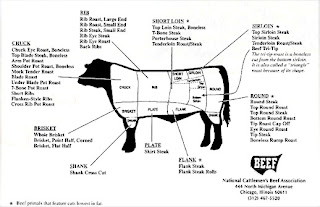Background-
I will be creating an info-graphic that shows and talks about different types of meat cuts on the most typically ordered meat in the US (beef, pork, lamb), their nutritional information, and where they are located on the animal. The client is Rain Shadow Meats a small local butcher store in the heart of downtown Seattle. The butcher store prides themselves in friendly service, quality meats, and a nod towards being local, organic and sustainable. The stores mission is to have the customer have the best experience possible they hope to do this by having an info graphic on meat cuts to help educate their customers on different meat choices before their final purchase.
Target Audience
Anyone that wants to know where there meat is coming from, and wants to better educated themselves on the nutritional value of each cut. Health critics, shoppers, cooks,ect.
Objectives
The objective is for the user to be more educated and to better understand the meat that they are about to be ingesting into their bodies. Where it is located,nutritional value, and where it probably came from.
Obstacles
The main obstacles will probably be language barriers, I will need to make sure my images speak for themselves, my diagram will also not include all meat things like chicken that don't have cuts wont be included and so people that want nutritional information on that with have to go somewhere else to find it.
Key Benefits
People will gain a better understanding on the meat they are eating, and possible choose healthier choices.
Support Statement
The benefits of creating this info graphic out weight the obstacles, because it is giving people information, if they don't understand it because of language barriers, they don't understand it and there is no harm done, however people that do understand it will be better informed and more knowledgeable because of it.
Tone
Light and educational tone.
Media
This will be on posters put up at chain supermarkets in the meat section where people purchase there cuts. It could also be on the web for those people that just want to educate themselves on meat cuts.
Creative considerations
The design of the info-graphic will hopefully be able to speak for itself but if it doesn't clarifications will only be in English. For the web there will be additional information because of the ability to hover, and click.







